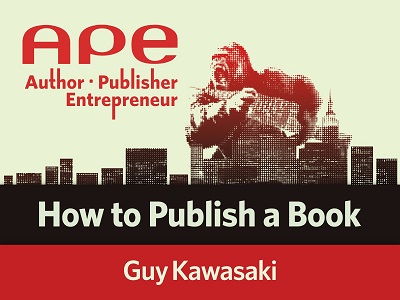Your cart is currently empty!

A.P.E., by G. Kawasaki and S. Welch
We’ve written before about e-books, but our experience (and therefore our advice) has been limited to e-books used for marketing at websites.
Creating an e-book in PDF form to offer to people in exchange for their contact information is a popular and successful way of growing your house list. We’ve written e-books of this kind for various clients with good results. However, if you have a winner of an e-book, you might want to publish it in other formats (Kindle, for example), sell it, and otherwise market it to get more from it than just some names for your house list. We’ve seen recently that having written a book, including an e-book, confers a lot of authority and visibility onto a website and its owner. Are you ready to get in on that?
APE: Author, Publisher, Entrepreneur-How to Publish a Book is what you need. For one thing, it’s written by Guy Kawasaki, so it’s a pleasure to read, whether you want to publish a book or not. Beyond that, it’s an extremely practical guide to publishing.
The book begins with a chapter asking “Should You Write a Book?” This is much more a “whither?” kind of chapter than you need if you’re thinking about an e-book for marketing purposes, and we completely disagree with the book’s claim that you shouldn’t hire someone to write it for you — but it’s just what you need if you have been thinking for years about writing a book. We know lots of people in that position, and we think they’d enjoy the pep talk.
This is followed by a discussion of traditional publishing and self-publishing. Having grown up in a family which was supported primarily by traditional publishing and worked in the book business for many years, I can vouch for the accuracy of this section. I think that a lot of the questions and concerns that paralyze people who have a desire to write a book are covered in this section, and you should complete it with a clear understanding of the issues involved.
Next comes an exhaustive how-to section which looks at thorny questions like what software you should use, what formats you should offer, and how exactly to get from that lengthy Word file to an actual book, whether EPub, Kindle, or a physical object. The authors not only compare a variety of methods, but they give step-by-step instructions for each one. If you have a book in any form at all right now, you will be able to follow these instructions and end up with a published book.
Finally, there is a discussion of how to market your book. Kawasaki is very good at this, so his suggestions are practical, sensible, and will work if you have a good book and follow through. His recommendations include email, a website, blogging, linkbuilding (by pitching to bloggers and reviewers) and social media; these are exactly the tools that we use for marketing, so we know they work. Again, the advice in these chapters is extremely specific, including points like how to take your Facebook photo and why you should use the active voice when you tweet.
The book ends with a case study: how the authors wrote, published, and marketed the book APE: Author, Publisher, Entrepreneur-How to Publish a Book. They tell you everything from the brand and model of computer they used to the specific company they chose to print the paper version of the book.
This is quite simply the best book I’ve seen on the topic of publishing in the 21st century.

Leave a Reply